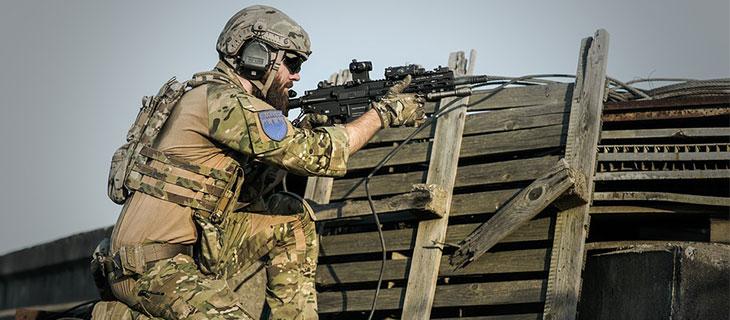9 Popular Plastics for Military Applications
For many decades plastics has been successfully used in military defense to produce strong and lightweight parts. Plastics have replaced metals in military applications due to its growing number of advantages. It is durable, waterproof, lightweight and does not conduct electricity. From simple hooks to delicate compass cases and very high precision weapons parts, plastic is considered safe and strong for military applications. Let us begin by understanding the advantages that plastic has to offer in the military.
Advantages of Plastic in Military Applications:
Plastic offers uniformity in applications and dependability in the field. They save time and money in production as large orders of precision items can be tailor-made to military specifications in less time. This is achieved by using plastic injection molding. Some examples are shielding sea-to-air missile components and hydraulic fittings.
Plastic offers freedom to design as they have fewer constraints in assembling multiple parts. This allows manufacturers to design complex geometries using the best suitable method for the application. Plastic in military applications offers high durability as it is resistant to chemicals, heat, moisture, and impact. Plastic military equipment does not require expensive secondary operations, such as machining or painting and can be designed with lesser parts. This helps in cutting down additional costs.
Plastic is lighter than metal and is used in military gear and equipment. The mobility of troops is immensely improved due to this. What’s more, plastic is also used in land, air and sea vehicles to reduce weight and improve fuel efficiency.

9 Popular Plastics that are used in Military Applications:
- Polypropylene – It is lightweight, heat and chemical resistant, tough and low in cost. It is used in military-grade containers, heavy-duty rope, and ties.
- Polyetheretherketone – It offers thermal stability, low moisture absorption, resistance to abrasion and chemical. It is used in aircraft components, seals, electrical connectors and pump impellers.
- Acetal – It is rigid, resistant to chemicals and moisture and low in cost. It is used in gears, slide guides, cams, rotors, handles, bearings, plumbing components.
- Thermoplastic Elastomer – It offers material stability, colorable, and good thermal properties. A thermoplastic elastomer is used in over-molding of handheld devices, night vision equipment, protective masks, boot soles, and soft touch grips.
- Polycarbonate – It is temperature resistant, offers dimensional stability, and toughness. It is used in safety helmets, shields, consoles, panels, light covers, and reflectors.
- Polyamide 6 – It is high in strength, low friction, cost-effective, and chemical resistant. It is used in rollers, wheels, gears, and bushings.
- Polyester – It is heat and chemical resistant, rigid, and cost-effective. It is used in cams, gears, electrical components, filters, and valves.
- Polyphenylene Sulphide – It is very high in strength, and shows good resistance to heat. It is used in covers, shields, fuel system components, and switches.
- Polyvinyl Chloride (PVC) – It is tough yet flexible, flame resistant, and low in cost. It is used in electrical insulation, and boot soles.
With rapid phase-product development, plastic manufacturers are equipped to produce highly complex plastic equipment for the military to rely on across different operations.
Visit Plastivision for more information on how plastic can make things easier for your business and sign in to be a part of our upcoming event.
Leave a Reply Cancel reply
Recent Posts
- Understanding The Materials That Are Used To Build Plastic Toys
- All You Need To Know About Food-grade Plastics
- A Glance At The Materials That Boost The Performance Of Plastics
- Understanding The Importance Of Exploring New Business Opportunities In The Plastic Industry
- Understanding The Importance Of Investing in R&D For The Plastic Industry
Categories
- 3D Printing
- AIPMA
- Automation
- Automobile Sector
- Bio Plastics
- Environment
- Innovations In Recycling
- Latest Innovations
- Molds & Dies
- News
- Packaging Industry
- Plastic
- Plastic Application
- Plastic Industry
- Plastic Market
- Plastic Myths
- Plastic News From The World
- Plastic Packaging
- Plastic Products
- Plastic Recycling
- Plastic Solar Cells
- Plastic Toys
- Plastic Waste
- Plastic World
- Plastics
- Plastics And Their Applications
- Plastics In Agriculture
- Plastics In Healthcare
- Plastics In Medical Industry
- Plasticulture
- Processing Machinery
- Recycling Machines
- Robotics
- Uncategorized
- Virtual Reality
Archives
- November 2023 (3)
- October 2023 (2)
- September 2023 (3)
- August 2023 (3)
- July 2023 (3)
- June 2023 (3)
- May 2023 (2)
- April 2023 (2)
- March 2023 (2)
- February 2023 (2)
- January 2023 (2)
- December 2022 (3)
- November 2022 (1)
- October 2022 (1)
- September 2022 (2)
- August 2022 (1)
- July 2022 (3)
- May 2022 (3)
- March 2022 (2)
- February 2022 (1)
- January 2022 (1)
- September 2021 (2)
- August 2021 (3)
- July 2021 (4)
- June 2021 (4)
- May 2021 (3)
- April 2021 (2)
- March 2021 (4)
- November 2019 (8)
- October 2019 (8)
- September 2019 (8)
- August 2019 (8)
- July 2019 (8)
- June 2019 (8)
- May 2019 (8)
- April 2019 (8)
- March 2019 (8)
- February 2019 (11)
- January 2019 (8)
- December 2018 (8)
- November 2018 (12)
- October 2018 (12)

